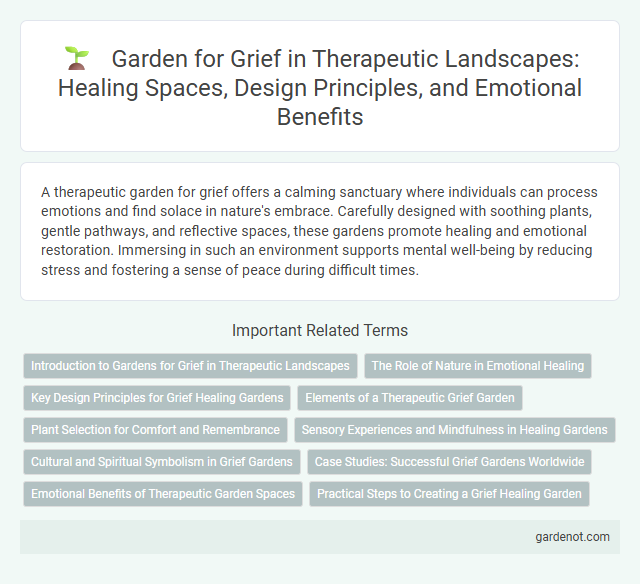A therapeutic garden for grief offers a calming sanctuary where individuals can process emotions and find solace in nature's embrace. Carefully designed with soothing plants, gentle pathways, and reflective spaces, these gardens promote healing and emotional restoration. Immersing in such an environment supports mental well-being by reducing stress and fostering a sense of peace during difficult times.
Introduction to Gardens for Grief in Therapeutic Landscapes
Gardens for grief in therapeutic landscapes serve as intentional spaces designed to support emotional healing and reflection. These gardens incorporate elements such as calming natural features, secluded seating, and sensory-rich plants to create a restorative environment for individuals coping with loss. Research indicates that exposure to green spaces in grief therapy can reduce stress, improve mood, and facilitate personal growth during bereavement.
The Role of Nature in Emotional Healing
Nature within therapeutic gardens offers a vital sanctuary for emotional healing by fostering tranquility and reflection essential for grief recovery. Elements such as flowing water, fragrant plants, and natural light stimulate sensory engagement, reducing stress and promoting mental restoration. These gardens support the grieving process by encouraging mindfulness and providing a peaceful environment where individuals can process loss and find solace through connection with the natural world.
Key Design Principles for Grief Healing Gardens
Grief healing gardens incorporate key design principles such as creating serene, reflective spaces with natural elements like water features, native plants, and comfortable seating to promote emotional restoration. Pathways are designed to encourage gentle movement and contemplation, while incorporating symbolism through art or memorials enhances personal connection and meaning. The integration of sensory experiences, including fragrances and textures, supports mindfulness and helps individuals process grief in a nurturing environment.
Elements of a Therapeutic Grief Garden
A therapeutic grief garden incorporates elements such as calming water features, fragrant plants, and secluded seating areas to foster reflection and emotional healing. Symbolic sculptures and memorial plaques provide personalized spaces for remembrance and connection. Accessible pathways and sensory-rich flora enhance comfort and encourage restorative experiences amid nature.
Plant Selection for Comfort and Remembrance
Choosing plants with soothing fragrances and gentle textures enhances the therapeutic benefits of gardens for grief, promoting comfort and emotional healing. Incorporating species such as lavender, rosemary, and white roses symbolizes remembrance and offers calming sensory experiences. Evergreen shrubs and perennials provide lasting structure, representing endurance and continuity amid loss.
Sensory Experiences and Mindfulness in Healing Gardens
Healing gardens designed for grief incorporate sensory experiences such as fragrant flowers, textured plants, and flowing water to evoke calmness and emotional release. Mindfulness practices within these therapeutic landscapes enhance healing by encouraging visitors to engage fully with present sensations, fostering a deeper connection to nature and inner reflection. These multisensory elements stimulate the senses and promote mental well-being, accelerating the recovery process from grief.
Cultural and Spiritual Symbolism in Grief Gardens
Grief gardens incorporate cultural and spiritual symbolism to provide solace and facilitate emotional healing, often featuring elements like sacred plants, ritualistic layouts, and culturally significant sculptures. These spaces use symbolic flora such as lotus, rosemary, and cypress trees, which represent purity, remembrance, and mourning across various cultures. Spiritual motifs embedded in the garden design offer a contemplative environment that honors diverse grief traditions, supporting meaningful reflection and connection.
Case Studies: Successful Grief Gardens Worldwide
Case studies of successful grief gardens worldwide highlight therapeutic landscapes that promote emotional healing and reflection through thoughtfully designed natural elements. The Garden of Remembrance in Dublin integrates native Irish flora and tranquil water features to provide solace and encourage collective mourning. In Singapore, the Healing Garden at Khoo Teck Puat Hospital uses sensory plants and peaceful pathways, enhancing psychological recovery for visitors dealing with loss.
Emotional Benefits of Therapeutic Garden Spaces
Therapeutic garden spaces for grief provide calming sensory experiences that promote emotional healing and reduce anxiety symptoms. Exposure to natural elements like flowers, water features, and greenery enhances mood regulation and fosters a sense of hope and renewal. These environments support coping mechanisms by encouraging mindfulness, reflection, and social connectivity among bereaved individuals.
Practical Steps to Creating a Grief Healing Garden
Designing a grief healing garden involves selecting soothing plants such as lavender and rosemary known for their calming and memory-enhancing properties. Incorporating quiet seating areas, water features, and pathways encourages reflection and emotional release. Practical steps include choosing a private location, using natural materials, and integrating personal mementos to foster a therapeutic and restorative environment.
Garden for grief Infographic

 gardenot.com
gardenot.com